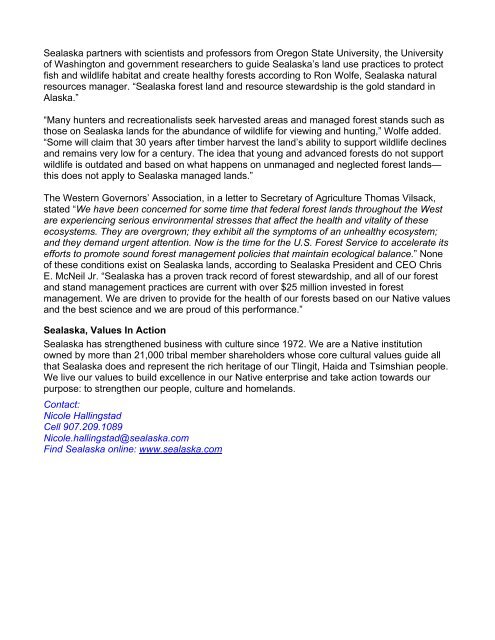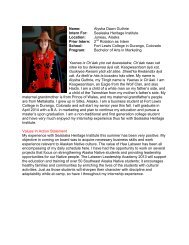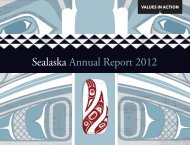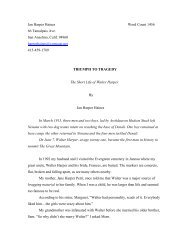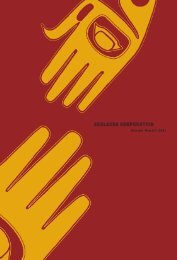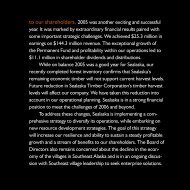Press Release: Sealaska Leadership Speaks Out for Land Legislation
Press Release: Sealaska Leadership Speaks Out for Land Legislation
Press Release: Sealaska Leadership Speaks Out for Land Legislation
You also want an ePaper? Increase the reach of your titles
YUMPU automatically turns print PDFs into web optimized ePapers that Google loves.
<strong>Sealaska</strong> partners with scientists and professors from Oregon State University, the University<br />
of Washington and government researchers to guide <strong>Sealaska</strong>’s land use practices to protect<br />
fish and wildlife habitat and create healthy <strong>for</strong>ests according to Ron Wolfe, <strong>Sealaska</strong> natural<br />
resources manager. “<strong>Sealaska</strong> <strong>for</strong>est land and resource stewardship is the gold standard in<br />
Alaska.”<br />
“Many hunters and recreationalists seek harvested areas and managed <strong>for</strong>est stands such as<br />
those on <strong>Sealaska</strong> lands <strong>for</strong> the abundance of wildlife <strong>for</strong> viewing and hunting,” Wolfe added.<br />
“Some will claim that 30 years after timber harvest the land’s ability to support wildlife declines<br />
and remains very low <strong>for</strong> a century. The idea that young and advanced <strong>for</strong>ests do not support<br />
wildlife is outdated and based on what happens on unmanaged and neglected <strong>for</strong>est lands—<br />
this does not apply to <strong>Sealaska</strong> managed lands.”<br />
The Western Governors’ Association, in a letter to Secretary of Agriculture Thomas Vilsack,<br />
stated “We have been concerned <strong>for</strong> some time that federal <strong>for</strong>est lands throughout the West<br />
are experiencing serious environmental stresses that affect the health and vitality of these<br />
ecosystems. They are overgrown; they exhibit all the symptoms of an unhealthy ecosystem;<br />
and they demand urgent attention. Now is the time <strong>for</strong> the U.S. Forest Service to accelerate its<br />
ef<strong>for</strong>ts to promote sound <strong>for</strong>est management policies that maintain ecological balance.” None<br />
of these conditions exist on <strong>Sealaska</strong> lands, according to <strong>Sealaska</strong> President and CEO Chris<br />
E. McNeil Jr. “<strong>Sealaska</strong> has a proven track record of <strong>for</strong>est stewardship, and all of our <strong>for</strong>est<br />
and stand management practices are current with over $25 million invested in <strong>for</strong>est<br />
management. We are driven to provide <strong>for</strong> the health of our <strong>for</strong>ests based on our Native values<br />
and the best science and we are proud of this per<strong>for</strong>mance.”<br />
<strong>Sealaska</strong>, Values In Action<br />
<strong>Sealaska</strong> has strengthened business with culture since 1972. We are a Native institution<br />
owned by more than 21,000 tribal member shareholders whose core cultural values guide all<br />
that <strong>Sealaska</strong> does and represent the rich heritage of our Tlingit, Haida and Tsimshian people.<br />
We live our values to build excellence in our Native enterprise and take action towards our<br />
purpose: to strengthen our people, culture and homelands.<br />
Contact:<br />
Nicole Hallingstad<br />
Cell 907.209.1089<br />
Nicole.hallingstad@sealaska.com<br />
Find <strong>Sealaska</strong> online: www.sealaska.com


